The GSD’s Early Design Education Programs: An Interview with Megan Panzano MArch ’10
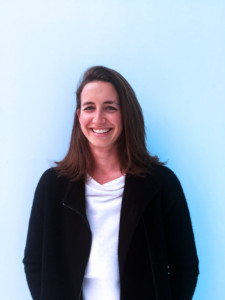
Megan Panzano MArch ’10
In 2021, the Harvard Graduate School of Design invested in a set of short introductory education programs that are directed at sharing the value of design with the global public. Early Design Education (EDE)—which invites different audiences to “think and make” through design—includes Design Discovery Virtual, Design Discovery in-person, and Design Discovery Youth summer programs; the Black in Design Mentorship program; and the Harvard Undergraduate Architecture Studies program.
Last June, Megan Panzano MArch ’10 was named senior director of Early Design Education to lead these programs in refreshed formats into the future. Harvard GSD’s Joshua Machat talks with Panzano about her plans for the EDE programs that include breaking down access barriers to design education, engaging diverse perspectives on what should drive design, and building a robust support system for students and those new to teaching design.
The Early Design Education programs introduce design ideas and practices to a wide range of audiences on a global scale. What are the methodologies students will be engaged with concerning the impact of design on the built environment and its potential for societal change?
The programs offer a great chance to share the value of design with an expanded public, and reciprocally, to include and value the voices that a diverse public brings to design. We’re invested in these programs bringing new forms of design agency to the individual ideas and perspectives of our global participants. And we’re working on making these programs as accessible to as many people as possible.
The “early” part of Early Design Education is not an age-dependent term. Rather it assumes that each program is one of the earliest experiences of design immersion and “thinking through making” that participants—ranging from mid-career professionals to high school students—have encountered. These programs aim to offer thoughtful instruction in the materials and scale of design across architecture, landscape architecture, and urban planning and design; workshops in tools used for design, such as 3D modeling and graphics programs; and, most critically, how to think about the world through a design lens.
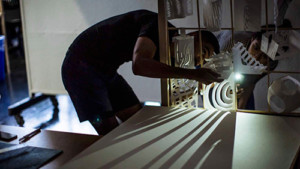
Harvard GSD Design Discovery Youth
The programs emphasize design as a method for asking important questions. The world is, and will continue to be, unavoidably instable—environmentally, politically, and socially. Our crafting of the Early Design Education programs accepts and claims that instability as a material of design. Rather than seeking a singular “right” answer or achieving a prescribed outcome, the programs teach how to use design to keep up with this evolution—to continuously question the world as we’ve come to know it. This happens by closely reading our context, seeing something that could be improved, naming it as a question, and directing design to impact it.
How has remote learning in the past two years impacted the EDE programs?
The required remote learning of the past two years has taught us many things, not all good. But there a few wonderful takeaways that we intend to hang onto. These positive qualities made it possible for us to conceive of a new format for our summer program, Design Discovery Virtual, which we will offer along with a refreshed version of our Design Discovery in-person program this summer and going forward. What’s been great is that now we have the chance to be intentional with constructing a virtual design education program, rather than simply reacting out of necessity of pandemic pressures.
We can easily bring diverse groups of people together from anywhere in the world to discuss design. That range of perspectives is incredible in conversation and as a way to expand one’s thinking. Within the context of our new virtual program, we note that peer-to-peer learning occurs as much as more conventional top-down organizations of learning from instructors.
Our virtual mode these past years has allowed us to learn and become quite good with programs, such as Miro and Slack, that make it easier to share work—both in-process as well as more polished—to collectively see and record design steps. Miro’s open virtual pin-up space visually collects elements in design processes and in works in progress such as drawings, 3D model images, design precedents and texts, and puts these on an equal plane with more complete finished final work for all members of a design studio. Because you can see your own design evolution beside those of your classmates, the program visually maps different learning paths along with design outcomes, a kind of meta level learning about learning. It’s a wonderfully powerful tool for those new to design.
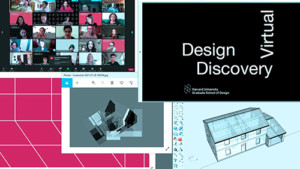
Harvard GSD Design Discovery Virtual
Sharing our ideas via virtual platforms requires us to be more clear and intentional with an argument and a narrative for our design work when presenting. As opposed to more conventional academic design presentations where a field of visual and modeled work would be pinned up and shown all at once to an audience, digital programs tend toward linearity of flipping through a presentation one slide after the next.
How do you see students in the Harvard Undergraduate Architecture Studies program benefiting from the interdisciplinary approach that teaches design “thinking through making” within the liberal arts context?
The Harvard Undergraduate Architecture Studies program is a special one within the EDE set because it is a joint endeavor between two schools at Harvard—the Faculty of Arts and Sciences and the Graduate School of Design. It’s a track of study within the history of art and architecture concentration, or major, at Harvard. The GSD has created and teaches four making-based courses annually as part of this degree of study. These courses draw architecture studies concentrators, but are also in high demand with computer science, engineering, history, and visual studies students. We teach architecture to undergraduates, not with the expectation that everyone will become a designer, but with the goal that those coming through our courses who go on to shape the world in any number of ways afterward, will do so with a true understanding of the value of design.
What new offerings are available in the undergraduate Architectural Studies program for students seeking more experience in design education?
I’m looking forward to launching a new version of a course that went on hold for the past two years: a lecture/workshop class next fall for Harvard College students on climate change, through design. The course will explore how material selection and construction practices could radically shift if driven by more sensitive and careful environmental concerns. The course will also study the formal and spatial outcomes of using entirely new building materials and assembly techniques.
It’s been a pleasure to have the support and enthusiasm of my colleagues in the History of Art and Architecture Department, David Roxburgh and Jennifer Roberts, to develop a process for students wishing to pursue a design thesis in their senior year at Harvard College. Going forward, this will be an honors-eligible option each year for our Harvard Architecture Studies students. I’m looking forward to working with more undergraduates pursuing design research on topics they are passionate about as an additional path of studying the impact of design on the important issues of today.
The EDE programs place a lot of emphasis on supporting design teaching opportunities for the current advanced students of the GSD. What are these opportunities and what structures are in place to develop teaching skills in design across all three disciplines?
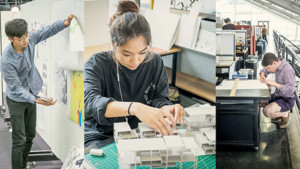
Harvard GSD Design Discovery
All of our EDE programs intentionally involve advanced GSD students as design instructors so that our current graduate students can gain design teaching experience, across all disciplines. We’ve been making some adjustments so that the programs in the EDE set call upon our GSD students to engage a different audience through different educational formats, and with varying degrees of agency to shape the design curriculum of the program. The intention is that the EDE programs provide a spectrum of design teaching experience that could build up if followed in sequence by current GSD students to help bridge them to post-degree academic positions. Our Design Discovery summer program, which has been around for more than 20 years, has a great track record of launching teaching careers in complement to design practice.
The Black in Design Mentorship program is rooted in the recognition that everyone benefits from mentorship, but not everyone has equal access due to racial inequalities and histories of disenfranchisement. What do you see as the most important factor in diversifying the design profession?
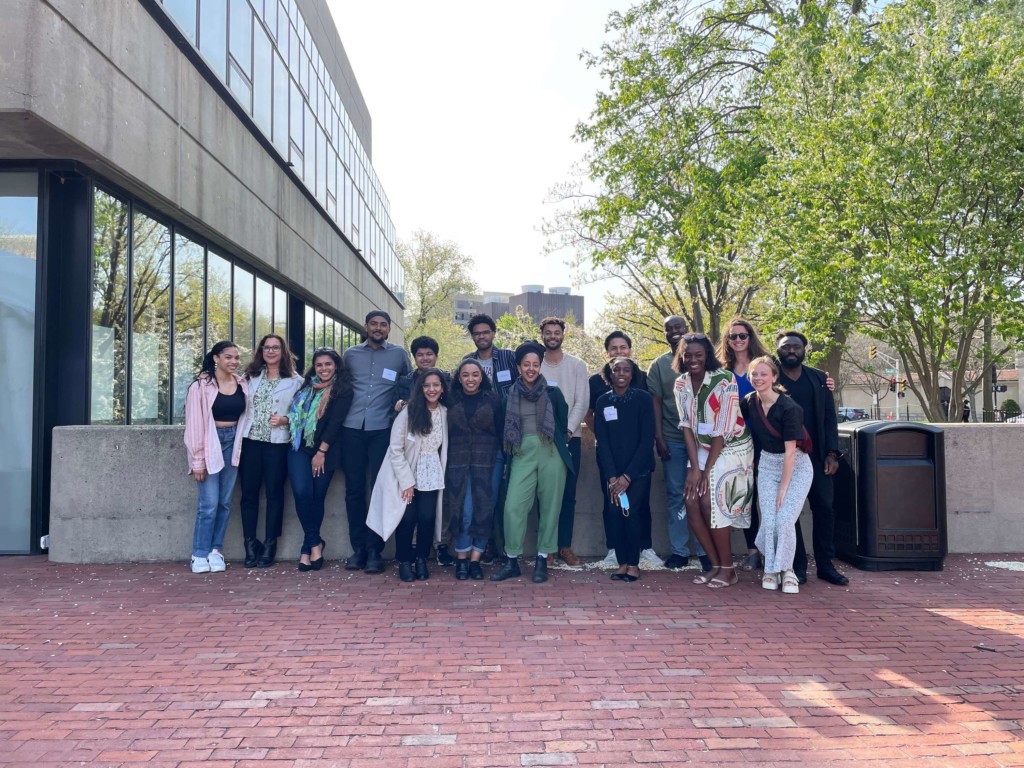
Members of the Black in Design Mentorship Class of 2022 visited Gund Hall in May to tour the building and celebrate the end of the program.
Recognizing and reevaluating what has been established, consciously and unconsciously, as “gate-keepers” to design is most pressing. This includes representation—seeing others like you in design and being able to project a path for yourself like theirs; affordability—considering the cost and time necessary for design education and professional licensure; geography—connecting design and its capacity to change the world as we’ve come to know it to the full range of global cultural heritages; and a sensitivity to the language we use to talk about design. If our profession is not appearing accessible to a diverse audience, one or more of those things are critically off. The design profession should be as diverse as the world we design within and for.
I’m honored to be working with a team of staff, students, and faculty who value these factors within the fields of design: Jenny French, Montserrat Bonvehi Rosich, Yun Fu, Kelly Wisnaskas, Ian Miley, Tosin Odugbemi, Rania Karamallah, Caleb Negash, Shaka Dendy, K. Michael Hays, and Sarah Whiting. Dean Whiting’s investment in Early Design Education has been critical in supporting the exciting plans we have to broaden design’s reach.
Story written by Joshua Machat for the GSD website.Harvard and the Legacy of Slavery
| Dear GSD Alumni and Friends, I write to encourage you to pause and take in yesterday’s email from President Bacow sharing the Report and Recommendations of the Presidential Committee on Harvard and the Legacy of Slavery. The report opens with the simple, direct claim that “Harvard’s motto, Veritas, inscribed on gates, doorways, and sculptures all over campus, demands of us truth.” The painful truths revealed in this carefully documented report betray the ethics represented by the word Veritas. The committee’s recommendations offer up just the beginning of a way forward for Harvard and for all of us. I am deeply grateful to the members of the Committee on Harvard and the Legacy of Slavery—appointed by President Bacow in 2019 and chaired by Tomiko Brown-Nagin, Dean of the Radcliffe Institute for Advanced Study—for undertaking this monumentally difficult task, in particular the contributions of the GSD’s own Stephen Gray, Associate Professor of Urban Design. I urge you all to read the report in its entirety. As designers, planners, historians, theorists, teachers, and citizens, it is critically important to learn about and know this part of our university’s history. The legacy of slavery at the university we call home is difficult to read, but also powerful in how it exemplifies how the ravages of slavery—while legally abolished in Massachusetts in 1783 and across the United States in 1865—were and continue to be inextricable from flows of global capital, the formations of modern cities as we know them today, and the repressive violence underlying them. The design and planning disciplines share culpability in this history—in their makeup as professionalized groups of experts and practitioners, and in the direct roles they play in planning for and designing the environments we inhabit. But as the committee’s recommendations make clear, the design and planning disciplines also have an important role to play in our reckoning with that history. There is an enormous amount of work to be done at Harvard, the GSD, and in our fields, and the committee’s recommendations and the university’s significant and sustained commitment of resources mark a valuable step forward toward progress. In the weeks and months ahead, we will consider and discuss with members of our GSD and Harvard communities the significance of the committee’s findings so as to begin to determine how best we might support the recommendations contained in the report, and where we might go from here. This work, which will be collective, will take many forms, and will be long ongoing. At the GSD, we all necessarily traffic in optimism—we aim at a better world—even if reading this history of Harvard can make it almost impossible to maintain any degree of optimism. And it is vital that we know its truth, as uncomfortable and painful as it may be, and keep that truth squarely in view as we gather our collective will toward repairing the devastations of the past and present, and strive for that better world for our families and loved ones, colleagues, and ourselves. In community, Sarah Sarah M. Whiting Dean and Josep Lluís Sert Professor of Architecture Harvard University Graduate School of Design |
Julie Bargmann MLA’ 87 Wins Inaugural Cornelia Hahn Oberlander International Landscape Architecture Prize
The Oberlander Prize, an initiative of The Cultural Landscape Foundation, includes a $100,000 award and two years of public engagement activities focused on the laureate and landscape architecture
The Cultural Landscape Foundation (TCLF) has named Julie Bargmann MLA ’87 the winner of the inaugural Cornelia Hahn Oberlander International Landscape Architecture Prize (Oberlander Prize), a biennial honor that includes a $100,000 award and two years of public engagement activities focused on the laureate’s work and landscape architecture more broadly. The Prize is named for the late landscape architect Cornelia Hahn Oberlander BLA ’47 and, according to TCLF, is bestowed on a recipient who is “exceptionally talented, creative, courageous, and visionary” and has “a significant body of built work that exemplifies the art of landscape architecture.”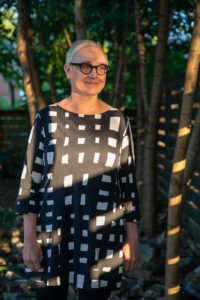
Julie Bargmann MLA ’87, 2021 Oberlander Prize laureate. Photo ©Barrett Doherty courtesy The Cultural Landscape Foundation
Talking Practice: Practice in an Uncertain World
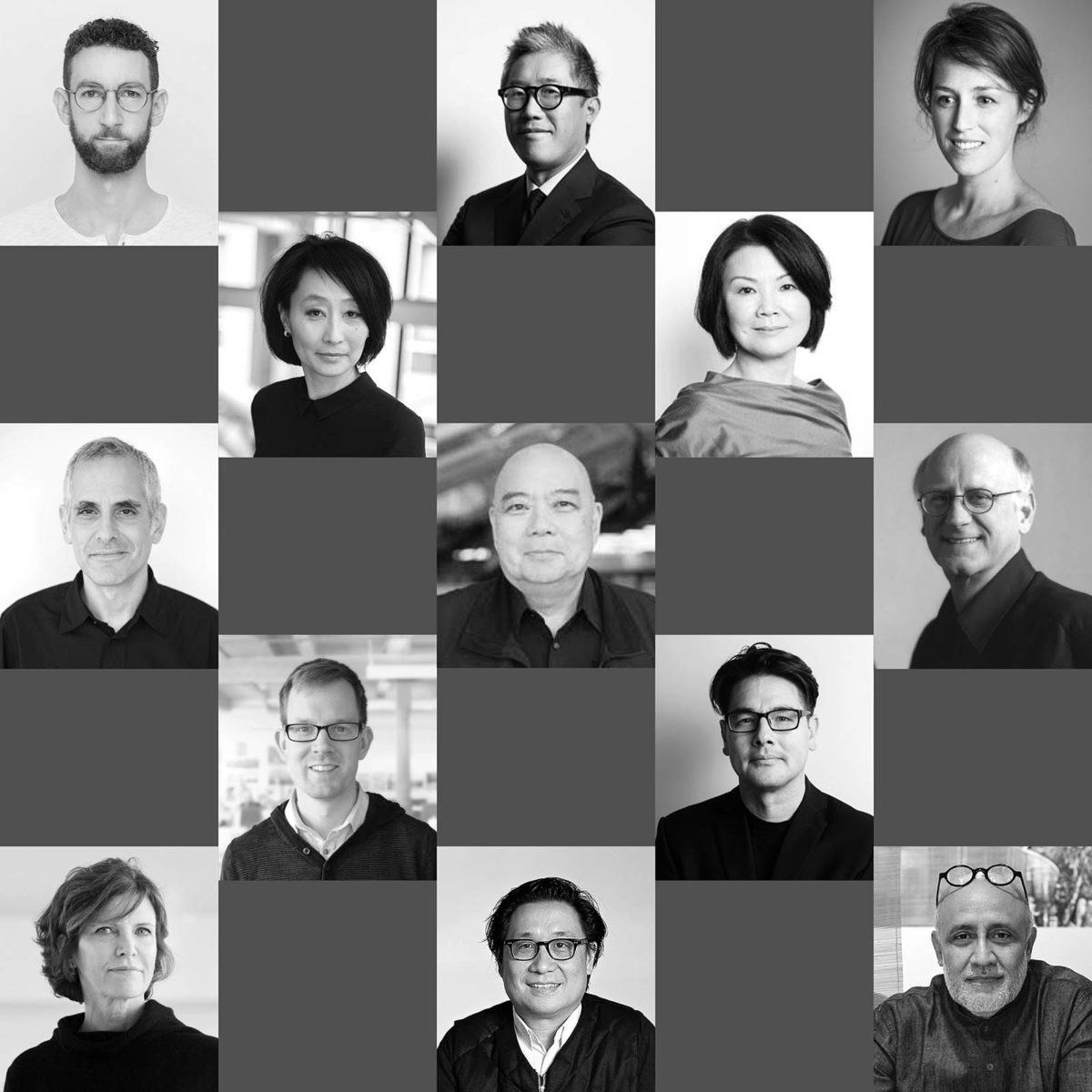 In this episode of Talking Practice, host Grace La MArch ’95 moderates a special roundtable, Practice in an Uncertain World. This informal event was recorded over zoom in May 2020, after the Harvard GSD evacuated its campus due to the COVID pandemic. The occasion gathered thirteen prominent architectural practitioners, who assembled on an early Saturday morning to share candid thoughts on the complexities of practice at this unprecedented moment. Featuring GSD faculty and alums, and representing different ages, geographic regions, and architectural practice type, the roundtable speakers include: Jeffry Burchard MArch ’08, Elizabeth Chrisoforetti MArch ’09, Scott Cohen MArch ’85, Jeanne Gang MArch ’93, Eric Howeler, Grace La, Mark Lee MArch ’95, Rahul Mehrotra MAUD ’87, Toshiko Mori, Paul Nakazawa, Lyndon Neri MArch ’92, Jacob Reidel, and Mack Scogin.
The conversation reveals a broad spectrum of insights and experiences. From the structuring of a fledgling office to the value of diversifying project type, the guests communicate the means by which they survived past recessions. They also discuss the importance of educating oneself outside the academy, acquiring “fitness” in new modes of thinking, and developing networks based on values and priorities. Spanning topics from the philosophical to the practical, they share their unique stories, advice, and reflections.
In this episode of Talking Practice, host Grace La MArch ’95 moderates a special roundtable, Practice in an Uncertain World. This informal event was recorded over zoom in May 2020, after the Harvard GSD evacuated its campus due to the COVID pandemic. The occasion gathered thirteen prominent architectural practitioners, who assembled on an early Saturday morning to share candid thoughts on the complexities of practice at this unprecedented moment. Featuring GSD faculty and alums, and representing different ages, geographic regions, and architectural practice type, the roundtable speakers include: Jeffry Burchard MArch ’08, Elizabeth Chrisoforetti MArch ’09, Scott Cohen MArch ’85, Jeanne Gang MArch ’93, Eric Howeler, Grace La, Mark Lee MArch ’95, Rahul Mehrotra MAUD ’87, Toshiko Mori, Paul Nakazawa, Lyndon Neri MArch ’92, Jacob Reidel, and Mack Scogin.
The conversation reveals a broad spectrum of insights and experiences. From the structuring of a fledgling office to the value of diversifying project type, the guests communicate the means by which they survived past recessions. They also discuss the importance of educating oneself outside the academy, acquiring “fitness” in new modes of thinking, and developing networks based on values and priorities. Spanning topics from the philosophical to the practical, they share their unique stories, advice, and reflections.
About the Show
Developed by Harvard Graduate School of Design, Talking Practice is the first podcast series to feature in-depth interviews with leading designers on the ways in which architects, landscape architects, designers, and planners articulate design imagination through practice. Hosted by Grace La, Professor of Architecture and Chair of Practice Platform, these dynamic conversations provide a rare glimpse into the work, experiences, and attitudes of design practitioners from around the world. Comprehensive, thought-provoking, and timely, Talking Practice tells the story of what designers do, why, and how they do it—exploring the key issues at stake in practice today.About the Host
 Grace La is Professor of Architecture, Chair of the Practice Platform, and former Director of the Master of Architecture Programs at Harvard University Graduate School of Design. She is also Principal of LA DALLMAN Architects, internationally recognized for the integration of architecture, engineering and landscape. Cofounded with James Dallman, LA DALLMAN is engaged in catalytic projects of diverse scale and type. The practice is noted for works that expand the architect’s agency in the civic recalibration of infrastructure, public space and challenging sites.
Grace La is Professor of Architecture, Chair of the Practice Platform, and former Director of the Master of Architecture Programs at Harvard University Graduate School of Design. She is also Principal of LA DALLMAN Architects, internationally recognized for the integration of architecture, engineering and landscape. Cofounded with James Dallman, LA DALLMAN is engaged in catalytic projects of diverse scale and type. The practice is noted for works that expand the architect’s agency in the civic recalibration of infrastructure, public space and challenging sites.
Show Credits
This special episode of Talking Practice is recorded and edited by Maggie Janik. Research, organization, and support for this episode is provided by John Wang.Contact
For all inquiries, please email [email protected].GSD Exhibitions Turn “Inside Out”
This spring, Harvard Graduate School of Design has turned its Druker Design Gallery, Experiments Wall, and other exhibition spaces “Inside Out,” with installations shown through a series of exterior projections on the building’s facade. The series, entitled “Inside Out,” will be screened nightly (4:00 pm to 11:00 pm, EST) through March 18, rotating through a weekly roster of shows that exhibit some recent preoccupations among Harvard GSD faculty and students, selected and curated from among an open call last November. From March 1 through March 7, “Inside Out” presents four films highlighting student work from Farshid Moussavi’s Fall 2020 GSD option studio, “Dual-Use: The function of a 21st century urban residential block.” The studio concerned itself with the politics latent within architecture, carried out through making aesthetic decisions regarding everyday spaces, and the resultant, and profound, consequences on people’s lives. In particular, the studio explored the subject of housing combined with working from home.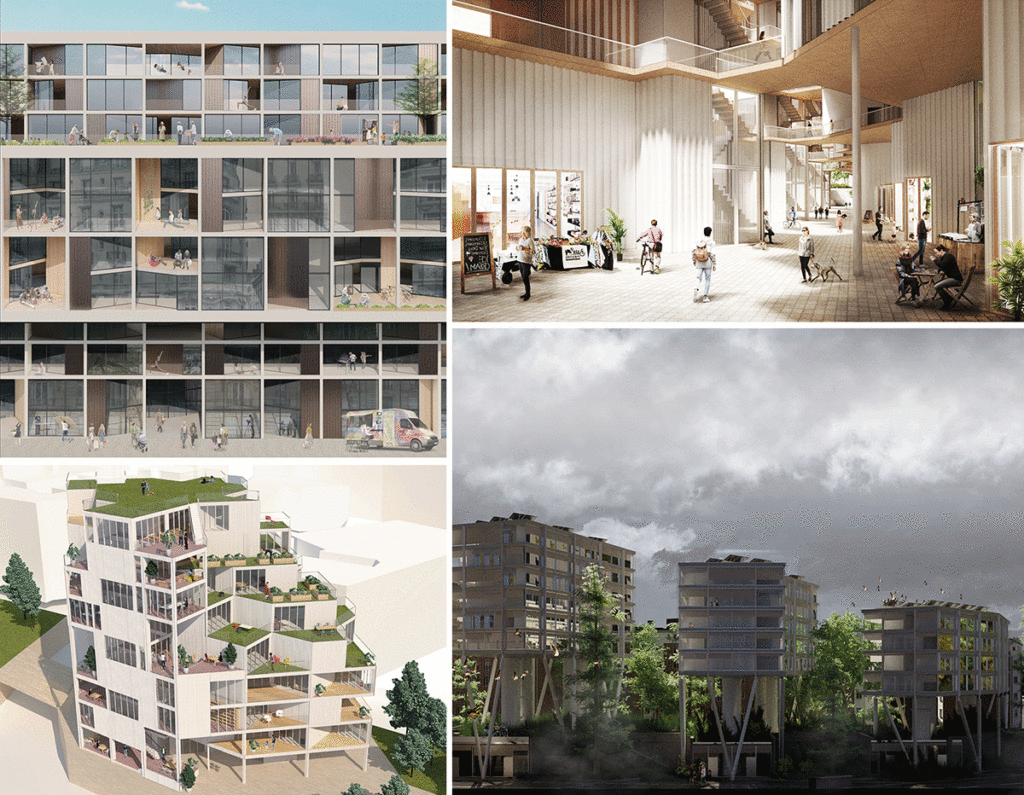
Projects currently on view in “Inside Out,” drawn from Farshid Moussavi’s Fall 2020 option studio “Dual-use: The function of a 21st century urban residential block.” Clockwise from top left: “Mutating Threshold” by Dan Lu, “Dual-Use Vertical Village” by Qin Ye Chen, “Dual-Use” by Erik Fichter, “Thrive – An Ethos of Collaboration and Support” by Devashree Shah
The Future of Air Travel: Designing a better in-flight experience
Anyone remember air travel? In early 2020, as the COVID-19 pandemic swept across the globe and international flights were hurriedly cancelled, the Harvard Graduate School of Design’s Laboratory for Design Technologies (LDT) pivoted its three-year focus project, The Future of Air Travel, to respond to new industry conditions in a rapidly changing world. With the broad goal of better understanding how design technologies can improve the way we live, the project aims to reimagine air travel for the future, recapturing some of its early promise (and even glamour) by assessing and addressing various pressure points resulting from the pandemic as well as more long-term challenges. The two participating research labs—the Responsive Environments and Artifacts Lab (REAL), led by Allen Sayegh, associate professor in practice of architectural technology, and the Geometry Lab, led by Andrew Witt, associate professor in practice of architecture—“look at air travel from an experiential and a systemic perspective.” As part of their research, the labs consulted with representatives from Boeing, Clark Construction, Perkins & Will, gmp, and the Massachusetts Port Authority, all members of the GSD’s Industry Advisors Group.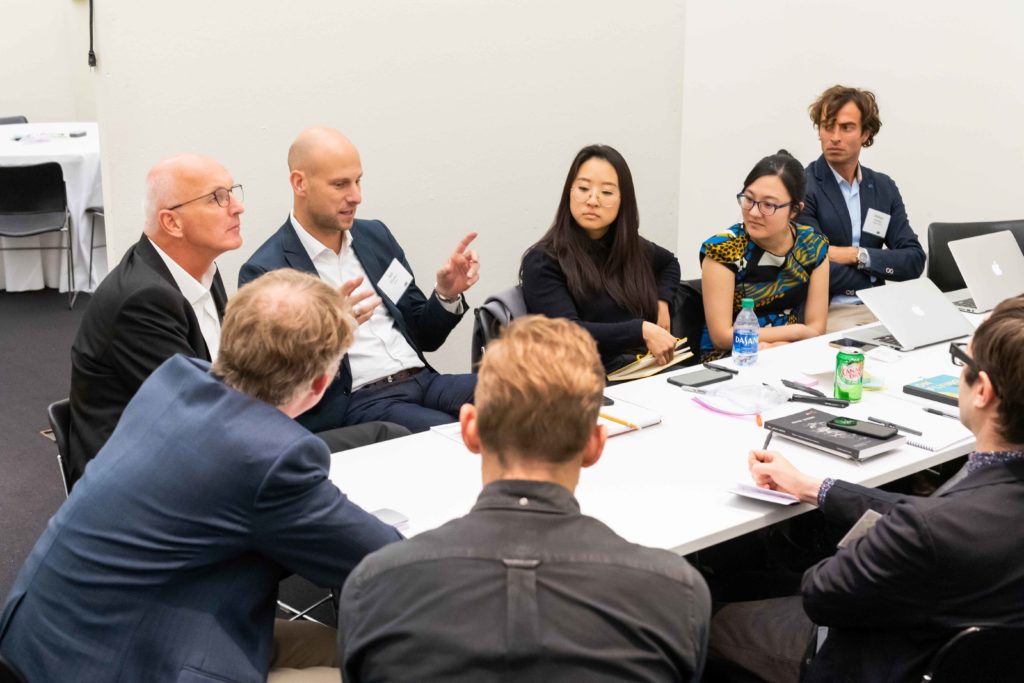
Pre-COVID-19 meeting with researchers and Industry Advisors. Clockwise from far left: Bryan Kirchoff (Boeing), Hans-Joachim Paap (gmp), Jan Blasko (gmp), Isa He, Humbi Song, Stefano Andreani, Andrew Witt, and Zach Seibold. Allen Sayegh, Tobias Keyl (gmp), Kristina Loock (gmp), and Ben LeGRand (Boeing) were also in attendance.
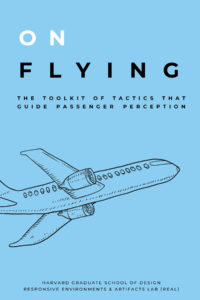 On Flying acknowledges that it’s hard to quantify many of the designed elements—ranging from artifacts to spaces and systems—that affect our experience of air travel. So the toolkit methodically catalogs and identifies these various factors before speculating on alternative scenarios for design and passenger interaction. A year into the project, Phase 2 will more overtly examine the context of COVID-19, considering it alongside other catastrophic events, such as 9/11, in order to better understand and plan for their impact on the industry as a whole and on passenger behavior.
On Flying acknowledges that it’s hard to quantify many of the designed elements—ranging from artifacts to spaces and systems—that affect our experience of air travel. So the toolkit methodically catalogs and identifies these various factors before speculating on alternative scenarios for design and passenger interaction. A year into the project, Phase 2 will more overtly examine the context of COVID-19, considering it alongside other catastrophic events, such as 9/11, in order to better understand and plan for their impact on the industry as a whole and on passenger behavior.
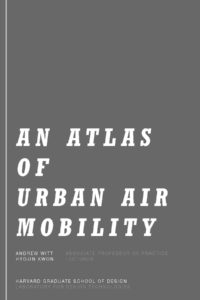 Meanwhile, the Atlas of Urban Air Mobility, by Witt and Lecturer in Architecture Hyojin Kwon, is “a collection of the dimensional and spatial parameters that establish relationships between aerial transport and the city,” and it aims to establish a “kit of parts” for the aerial city of the future. Phase 1 considered the idea of new super-conglomerates of cities, dependent on inter-connectivity of air routes—specifically looking at the unique qualities of Florida as an air travel hub. The atlas investigates flightpath planning and noise pollution and other spatial constraints of air travel within urban environments. One possible solution it raises is the concept of “clustered networks,” where electrical aerial vehicles could be used in an interconnected pattern of local urban conurbations, reflecting a hierarchy of passenger flight, depending on scale and distance traveled.
Phase 2 will move into software and atlas development, expanding the atlas as well as their simulation and planning software. One intriguing aspect will be a critical history of past visions of future air travel: a chance to look back in order to look forward with fresh eyes. By studying our shared dream of air travel, the hope is to rediscover and reboot abandoned visions that may yet prove to inspire new innovations.
Meanwhile, the Atlas of Urban Air Mobility, by Witt and Lecturer in Architecture Hyojin Kwon, is “a collection of the dimensional and spatial parameters that establish relationships between aerial transport and the city,” and it aims to establish a “kit of parts” for the aerial city of the future. Phase 1 considered the idea of new super-conglomerates of cities, dependent on inter-connectivity of air routes—specifically looking at the unique qualities of Florida as an air travel hub. The atlas investigates flightpath planning and noise pollution and other spatial constraints of air travel within urban environments. One possible solution it raises is the concept of “clustered networks,” where electrical aerial vehicles could be used in an interconnected pattern of local urban conurbations, reflecting a hierarchy of passenger flight, depending on scale and distance traveled.
Phase 2 will move into software and atlas development, expanding the atlas as well as their simulation and planning software. One intriguing aspect will be a critical history of past visions of future air travel: a chance to look back in order to look forward with fresh eyes. By studying our shared dream of air travel, the hope is to rediscover and reboot abandoned visions that may yet prove to inspire new innovations.
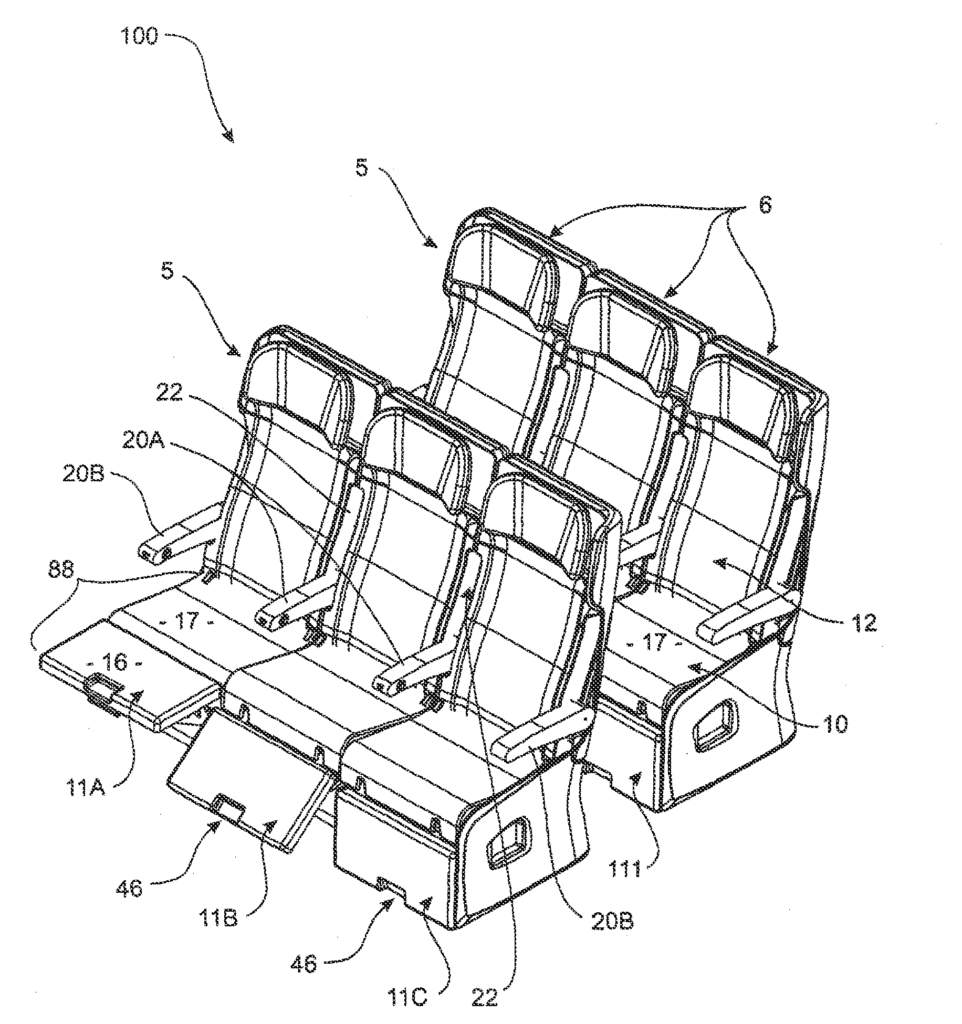
Armrest research from the Air Travel Design Guide: Patent for airplane seats showing ambiguity of armrest spatial “ownership” for middle seats
GSD Podcast Roundup
Harvard University Graduate School of Design (GSD) presents two podcast series featuring in-depth interviews with leading design practitioners from around the world. “Talking Practice,” produced by the Practice Platform, investigates the ways in which architects, landscape architects, designers, and planners articulate design imagination through practice. “Future of the American City,” from the Office for Urbanization, explores alternative futures and convenes conversations about how we live, where we live. Learn more below about both series and how to listen.Talking Practice
Hosted by Grace La MArch ’95, professor of architecture and chair of the practice platform, each 40-minute episode provides a rare glimpse into the work, experiences, and attitudes of design luminaries, many of whom are GSD alumni. Comprehensive, thought-provoking, and timely, “Talking Practice” tells the story of what designers do, why, and how they do it—exploring the key issues at stake in practice today. Episodes include:- Lyndon Neri MArch ’92 and Rossana Hu, partners and co-founders of Neri&Hu Design and Research Office, and the John C. Portman Design Critics in architecture at the GSD.
- Preston Scott Cohen MArch ’85, founder and principal of Preston Scott Cohen Inc, and Gerald M. McCue Professor in Architecture at the GSD.
- Gary Hilderbrand MLA ’85, founding principal and partner at Reed Hilderbrand, and Peter Louis Hornbeck Professor in Practice of Landscape Architecture at the GSD.
- Anna Heringer, founder and principal of Anna Heringer Architects, and honorary professor of the UNESCO Chair of Earthen Architecture, Building Cultures, and Sustainable Development
- Shohei Shigematsu, partner at Office of Metropolitan Architects (OMA) and head of the New York office.
- Paul Nakazawa, Associate Professor in Practice of Architecture at the GSD.
- Jeanne Gang MArch ’93, founder and principal of Studio Gang, Professor in Practice at the Harvard Graduate School of Design, and 2011 MacArthur Fellow.
- Reinier de Graaf, the longest non-founding partner at the Office of Metropolitan Architects and co-founder of AMO, the think tank of OMA.
Future of the American City
 Supported by the John S. and James L. Knight Foundation and generous donors to the American Cities Fund, this series of 10 episodes lanched in May 2019; it investigates Miami and other urban areas considering issues related to urban planning, adaptation to climate change, transit, equity and more.
The most recent episode from December 2019 features Associate Professor of Architecture Eric Höweler, an architect and educator whose work deals with building technology and the public realm. He and Alumni Council member Corey Zehngebot MArch ’09 led the fall 2019 option studio “Adapting Miami Housing on the Transect,” which centered on new strategies for urban housing, focusing on the issues of typology, density, transit, and climate adaptability.
Supported by the John S. and James L. Knight Foundation and generous donors to the American Cities Fund, this series of 10 episodes lanched in May 2019; it investigates Miami and other urban areas considering issues related to urban planning, adaptation to climate change, transit, equity and more.
The most recent episode from December 2019 features Associate Professor of Architecture Eric Höweler, an architect and educator whose work deals with building technology and the public realm. He and Alumni Council member Corey Zehngebot MArch ’09 led the fall 2019 option studio “Adapting Miami Housing on the Transect,” which centered on new strategies for urban housing, focusing on the issues of typology, density, transit, and climate adaptability.
 The other nine episodes include interviews with:
The other nine episodes include interviews with:
- Sean Canty MArch ’14 is an architect and educator whose work focuses on building type and geometry. Among other things, he has recently engaged in teaching a course on reimagining housing and public space in Miami’s Overtown neighborhood.
- Laurinda Spear and Margarita Blanco are architects and landscape architects whose work at ArquitectonicaGEO focuses on creating ecologically performative public spaces.
- Rodolphe el-Khoury is an architect, historian, and educator whose recent work deals with smart cities and embedded technology.
- Elizabeth Plater-Zyberk is a pioneering urban planner, architect, and educator. She has been instrumental in developing the City of Miami’s form-based zoning code, Miami 21.
- Craig Robins is a Miami real estate developer whose projects focus on arts, culture, and historic preservation.
- Rosetta S. Elkin is a landscape architect who uses design as a means to address risk, injustice, and instability brought on by climate change.
- Lily Song is an urban planner whose work aims to center the experiences of marginalized groups in the policy and development process.
- Chris Reed is a landscape architect specializing in dynamic ecologies and generative processes.
- Toni L. Griffin LF ’98 is an urban planner who employs a value-based approach to urbanism, examining the ways design and planning figure into to questions of equality and inclusion. Griffin’s pursuit of the “Just City” has led her across the country to push for urban design that promotes access, choice, and empowerment.
